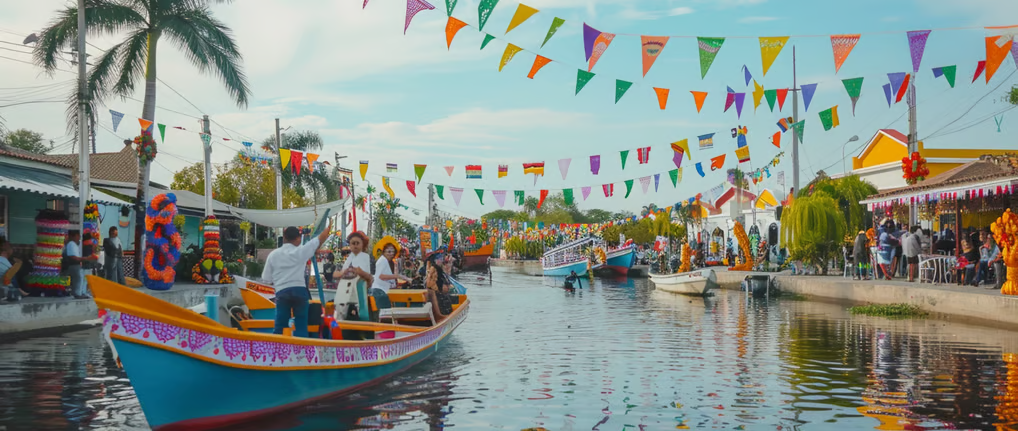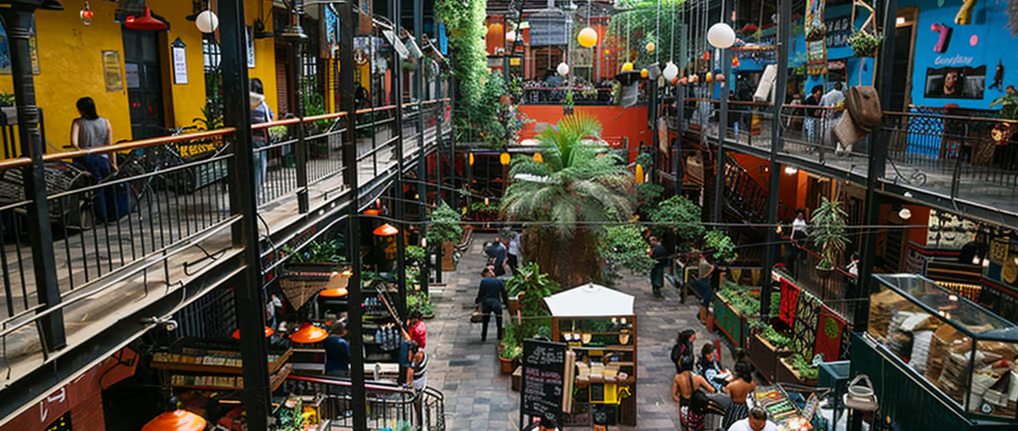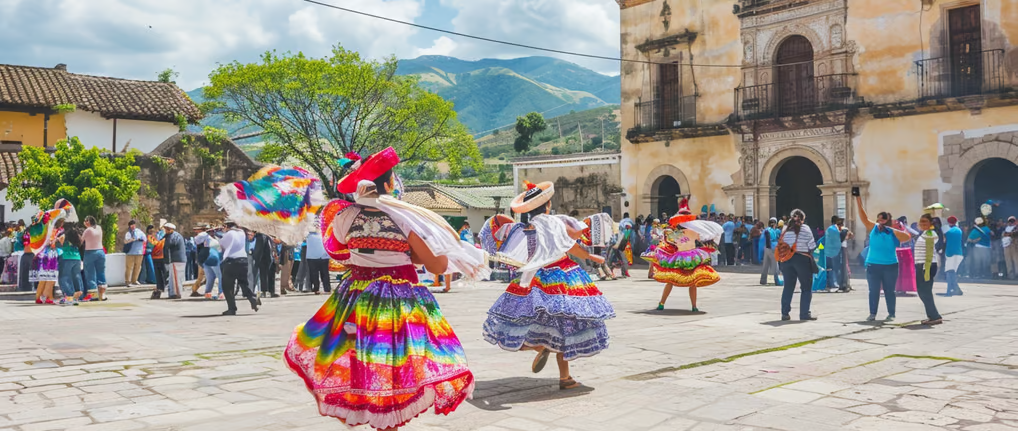The Colors of Mexico: A Journey Through Vibrant Markets and Festivals
Immerse yourself in Mexico's kaleidoscope of colors with a journey through its vibrant markets and festivals, where the spirit of the country is expressed in lively hues, intricate crafts, and jubilant celebrations.

Mexico is a country rich in color and culture, where every corner is ablaze with vibrant hues and every festival is a riot of color. From the bustling markets to the extravagant celebrations, the colors of Mexico are a feast for the senses. In this article, we will take you on a journey through the mesmerizing markets and lively festivals of Mexico, and explore the significance of color in Mexican tradition, cuisine, art, and craft.
Understanding Mexico's Colorful Culture
Mexico's culture is deeply rooted in color. It is a country where color isn't merely a superficial aesthetic, but a language of expression and meaning. In Mexican tradition, colors hold significance and are used to convey emotions, beliefs, and identity. Each color represents something unique, and together, they create a tapestry that is distinctly Mexican.
The Significance of Color in Mexican Tradition
In Mexican tradition, color plays a vital role in various aspects of life, including art, clothing, and religious rituals. For example, the vibrant colors of traditional clothing, such as the embroidered dresses and sombreros, reflect the rich cultural heritage of different regions. The intricate patterns and bold hues of these garments not only showcase the skill of Mexican artisans but also serve as a visual representation of the diversity and vibrancy of the Mexican people.
Moreover, colors are often used in religious ceremonies to symbolize different saints or deities, with each color carrying its own spiritual meaning. For instance, the color blue is associated with the Virgin Mary, representing purity and protection, while the color red is often linked to the passion and sacrifice of Jesus Christ. These symbolic colors not only enhance the visual spectacle of religious rituals but also deepen the spiritual connection between the worshippers and their beliefs.
The Role of Color in Mexican Festivals
Mexican festivals are renowned for their explosive displays of color. Whether it's the lively Dia de los Muertos (Day of the Dead) or the exuberant Carnaval, these celebrations bring entire communities together in a riot of color and joy. Colorful costumes, intricately designed floats, and vibrant decorations transform the streets into a kaleidoscope of hues, creating an immersive experience that is unforgettable.
During Dia de los Muertos, families create elaborate altars adorned with marigolds, known as the flower of the dead, and colorful papel picado, intricately cut paper banners. These vibrant decorations not only honor the deceased but also symbolize the belief that death is a natural part of life, to be celebrated rather than feared. Similarly, during Carnaval, participants don vibrant masks and costumes, each color symbolizing a different aspect of the celebration. The bright yellows represent joy and happiness, while the fiery reds embody passion and energy.
Furthermore, the use of color in Mexican festivals goes beyond aesthetics. It serves as a visual language that unites people, transcending language barriers and cultural differences. The vibrant colors create a sense of unity and belonging, fostering a collective spirit of celebration and togetherness.

Exploring Mexico's Vibrant Markets
Mexico's markets are a treasure trove of colors, offering a glimpse into the country's rich heritage and diverse culture. From bustling urban markets to charming rural bazaars, these vibrant hubs are where locals and tourists alike come to immerse themselves in the sensory delights that Mexico has to offer.
The Array of Colors in Mexican Markets
Step into any Mexican market, and you'll be greeted with an explosion of colors. The stalls are adorned with bright textiles, handcrafted pottery, and intricate jewelry, all showcasing the stunning artistry of Mexican artisans. From the earthy tones of Oaxaca's pottery to the vibrant hues of Guadalajara's textiles, each region has its own color palette, reflecting the unique identity of its people.
The Influence of Color in Mexican Commerce
Color has a significant influence on Mexican commerce, as it plays a crucial role in attracting customers and showcasing the diverse range of products. From the vibrant display of fruits and vegetables to the eye-catching packaging of artisanal products, color is used to entice and captivate shoppers. Whether it's the vibrant red of chili spices or the luscious green of avocados, color enhances the visual experience of shopping in Mexican markets.
Moreover, color also holds cultural significance in Mexican markets. For example, the color yellow is often associated with happiness and celebration, which is why you'll find an abundance of yellow marigolds, known as "cempasúchil," during the Day of the Dead festivities. These flowers, with their vibrant yellow petals, are believed to guide the spirits of loved ones back to the world of the living.
In addition to the cultural significance, color is also used strategically in Mexican markets to differentiate between products and create a sense of variety. For instance, in the textile section of a market, you'll find a dazzling array of fabrics in every color imaginable. This allows customers to easily distinguish between different types of textiles and select the ones that resonate with their personal style and preferences.
The Festive Colors of Mexico
When it comes to festive celebrations, Mexico knows how to put on a show. The country is renowned for its colorful and lively festivals, each with its own unique blend of traditions, music, dance, and, of course, vibrant colors.
The Colorful Spectacle of Mexican Festivals
Mexican festivals are an explosion of color, filling the streets with an infectious energy. The streets are adorned with papel picado, vibrant paper cutouts that flutter in the wind, and altars are filled with marigolds, the vibrant orange flowers symbolizing the presence of departed loved ones during Dia de los Muertos. Each festival has its own signature colors, creating a visual spectacle that is unlike anything else in the world.
The Symbolism of Colors in Mexican Celebrations
Colors hold deep symbolism in Mexican celebrations, representing various aspects of life and culture. For example, the color red is often associated with passion and love, while green signifies hope and renewal. By understanding the symbolism behind the colors, one can gain a deeper appreciation for the meaning and intention behind each festival.

The Colors of Mexican Cuisine
In Mexico, even the cuisine is a vibrant affair. From the colorful ingredients to the artfully presented dishes, Mexican food is a visual feast that stimulates both the taste buds and the eyes.
The Visual Feast of Mexican Food
Mexican cuisine is a cornucopia of colors, with each dish incorporating a vibrant array of ingredients. From the fiery red of chili peppers to the vibrant yellow of ripe mangoes, the colors in Mexican food reflect the natural abundance of the country. Every dish is a work of art, with vibrant salsas, garnishes, and toppings adding visual appeal to every meal.
The Role of Color in Traditional Mexican Dishes
Color plays a significant role in traditional Mexican dishes, not only in terms of aesthetics but also in flavor and texture. For example, the bright green of guacamole signals the creamy and rich taste of avocados, while the fiery red of salsa indicates the spicy kick that awaits. Color also influences the perception of taste, as the visual appeal of a dish can enhance the overall dining experience.
The Colors of Mexican Art and Craft
Mexican art and craft are renowned for their vibrant colors and exquisite craftsmanship. From the intricate murals of Diego Rivera to the ornate embroidery of Chiapas, Mexico's artistic heritage is a celebration of color and creativity.
The Vibrant Palette of Mexican Art
Mexican art is characterized by a bold and vibrant use of color. Whether it's the vivid hues of Frida Kahlo's self-portraits or the kaleidoscope of colors in traditional murals, Mexican artists use color to bring their creations to life. The vibrant palette reflects the country's passion, energy, and deep connection to its cultural roots.
The Colorful World of Mexican Handicrafts
Mexican handicrafts are a testament to the talent and skill of local artisans. From intricately woven textiles to vibrant ceramics and elaborate papel picado, each handicraft showcases the vibrant colors and rich heritage of Mexico. Whether you're browsing the markets of Mexico City or exploring the quaint villages of Oaxaca, you'll be captivated by the kaleidoscope of colors that adorn the handcrafted treasures.
In conclusion, a journey through the vibrant markets and festivals of Mexico is a feast for the senses. The colors of Mexico paint a picture of a country deeply rooted in tradition, where every hue tells a story. Whether you're exploring the bustling markets or immersing yourself in the lively festivals, you'll be enchanted by the vivid palette that surrounds you. So pack your bags and embark on a colorful adventure through the heart of Mexico. And remember, the colors of Mexico are waiting to be discovered, one vibrant hue at a time!